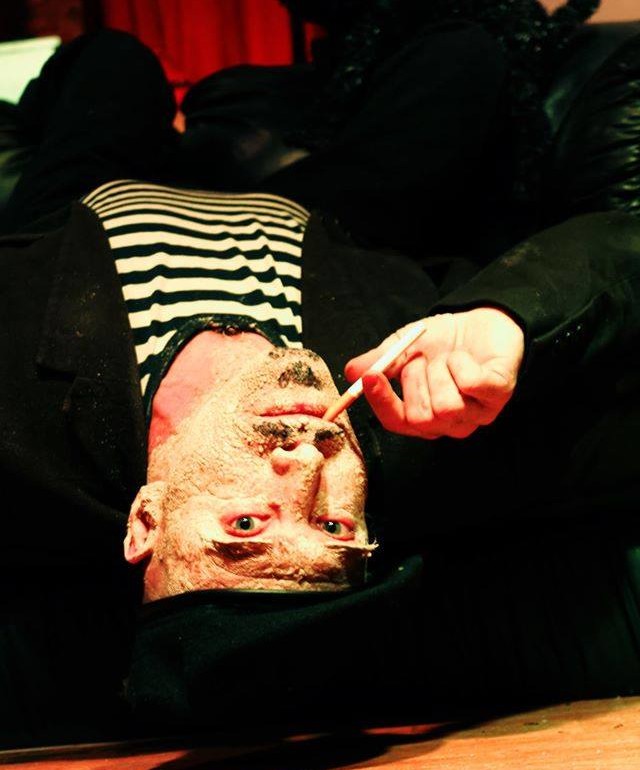Ladies and gentlemen, step right up! You think you understand art and culture? You’re about to discover that art and culture as you know it may in fact be older than you are. In a TheatreBloom exclusive interview to promote his upcoming TED-style conference talk appearing at the Hotel RL Baltimore— as a part of Hotel RL’s on-going The Living Stage Experience project— Yellow Sign Theatre’s Founder and Artistic Director Craig Coletta sits down to explain his approach to theatre in the arts. Going in depth with the carnie of Charm City, readers have the chance to be mesmerized by his silver-tongued logic when it comes to just how art should be.
Thank you for your time this evening, we all know you’re very busy. If you’d like to start us off with a quick introduction for those readers who are less familiar with who you are?
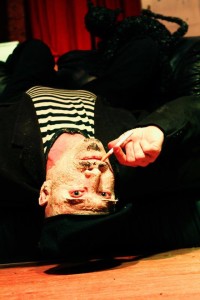
Craig Coletta: Well, I’m Craig Coletta. Currently the Artistic Director of Yellow Sign Theatre.
And what is this talk that you’re giving at Hotel RL Baltimore?
Craig: Hotel RL, which used to be the Hotel Red Lion Hotel chain, has built a new hotel here in Baltimore. I believe they have 47 other properties now and in each of these hotels they have put a small stage. The idea is that in each of the cities they serve they want to bring in as many local artists as they can— everything from performers, writers, thinkers, and so on— to keep that stage busy every night. They’ll be showcasing everything from short performances to TED-talk style talks, all in 20 minutes—
I’m sorry. You’re doing a talk that is only allowed to last 20 minutes?
Craig: Yeah, it’s not going to be easy. But the idea is to expose the people who will be staying at the hotel to the arts and creativity and various performance options in the city in which they’re staying. Then will be taping the performances and playing them on their in-house TV channel. I believe the idea is that roughly by March of 2016 all of the RL Hotels will be showing content from all of the other RL Hotels. This is an opportunity for Baltimore artists, performers, and thinkers to introduce people who are coming to the city to what they do, and then get exposed through other broadcasts to people in other cities in an attempt to draw people to the city.
What I’m doing is essentially presenting the long, unwritten Yellow Sign Theatre mission statement in 20 minutes or less, I know, I know, you’re laughing, I did say it was going to be difficult. But I’m going to explain that mission statement as the Yellow Sign’s approach to art. The title of the talk is Art Doesn’t Have to be Arty, in Fact, it Shouldn’t Be. It’s the principles I formed the theatre company under explained as a general philosophy of the type of work that we like to do, but then as a larger question of what makes art and what art actually is.
I’m curious as to what makes you think you’re qualified to say what makes art versus what doesn’t make art or what art is versus what it isn’t?
Craig: Oh I don’t. I only have one perspective to give on it. But it’s a perspective, that from my position, appropriately chastises the people who create the type of art I hate, which is a lot of art. And it’s not just stuff that appeases the masses. My schema has always been based on the schema that we used in folklore for studying teaching patterns. Myth tells you how to relate to the larger universe. Legend tells you what things could be like if we were all just a little bit better. And Folklore or Folktale tells you the skills and qualities you need to prosper in your own context. So if you want your kids to be risk takers, and ambitious and dreamers you tell them Jack and the Beanstalk. If you want them to be compassionate, you tell them the story of The Grateful Dead, it’s an old folktale motif that’s where the band got the name, it’s in the Aarne Thompson classification index.
The way I look at it is, high art seems to fit the role of myth. It talks about our aspirations as a culture. It talks about those larger issues in a large way. Are we on the right course? What do we want to be? Are we succeeding in that? And so on. Legend has sadly been replaced by middle-brow bullshit.
Such as?
Craig: Harry Potter. Harry Potter infuriates me. The only thing good I can say about it is that it did in fact get kids to read. If I want to read a British schoolboy novel I will read Tom Brown’s Schooldays, thank you very much. If I want to read an adventure story, a coming-of-age story, or a magic story, there are others that are better out there.
Why are you so angry?
Craig: I’m angry when the mediocre is hailed as genius. This happens all too often in art and theatre today.
So be the change you want to see in the world and make things that are not mediocre to be hailed as genius?
Craig: I make things— I hope they’re not mediocre. I don’t care if they’re hailed as genius or not, but at least they are not mediocre.
Getting back on track with your replacement system of Myth, Legend, and Folklore as it relates to modern art?
Craig: Right. So Legend, at its best what it did was present a heightened world. The Arthurian legends suggest what the world would be like if kings were truly noble and knights were truly compassionate and brave. The legends of the old west in American culture; what if making things work was as simple as keeping your word, shooting straight, and being polite to the ladies?
So why isn’t it as simple as that?
Craig: Because the world is more complicated than that. What legend ultimately does is sets a role model for us to be better. People talk about escapist fiction, and comic books come up a lot as “modern mythology.” Well they’re not modern mythology they’re modern legendry. And they’re good legendry. They set the model for how we could be. The problem is what makes legend work is that it’s heightened and certainly with film and to some extent with novel, you can create a heightened reality in which people are a hell of a lot worse than they actually are. But that’s “cool.” I can’t tell you how many people I know who based their personal aesthetic and even career choices on Cyberpunk, essentially Neuromancer.
Who or what is Neuromancer?
Craig: Neuromancer is a slick Blade Runner-ish “SciFi-Noir”, which was the term before they coined the term Cyberpunk, novel. It’s also a fucking dystopia. Basing your costumery or your career choices on a dystopian novel is like saying “I’m going to wear a gray jumpsuit and become a political spin doctor because I thought 1984 was cool. That’s roughly how I divide the notions of high art and low art. Low art speaks to a culture’s day to day realities in very practical and visceral ways.
Such as?
Craig: If you want to understand American attitudes toward race you better watch Pro-Wrestling. You’re talking about an art form that thrives by reinforcing any bias its audience has. What works for a non-white performer— what makes them a star, what makes them a hero or a villain, or what switches them from one to the other— that will tell you something about where America is standing. The greatest political film that’s ever been made is Night of the Living Dead.
Why do you think a zombie flick is a political film?
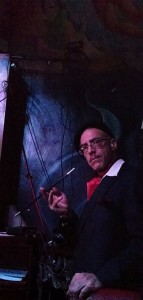
Craig: It’s an intensely political film. It was made as a political film. Romero made it as commentary on the upheaval in the late 60’s, remember it was made in ’68. And he made a tremendously political choice in casting a black man in his hero role and never, ever saying a word about race, and then at the very, very end, having him mistaken for a zombie and shot. But Romero went further than he thought with the political because the four principle characters in that story model the way I have seen Americans respond to every social crisis since I’ve been alive. He essentially described why we fuck up politically. All of those things come into The Yellow Sign’s aesthetic and approach to art.
I think this is the part where I ask you to lay out the three pillars of that infamous mission statement that you are saying isn’t actually written down anywhere. Because I’m going to transcribe it and then people can actually read it in print and you won’t be able to say it isn’t written down anywhere anymore.
Craig: The first pillar of the mission statement is: “Popular culture is older than you are.” If you understand the popular culture of an older era, you understand your own better. There’s more richness there for you to appreciate. And you don’t get duped into thinking something is novel and new when it’s just taking advantage of your short cultural memory…
Wait for it…
Craig: Lady Gaga! The woman made a career out of tearing pages out of Interview magazine from ’74 to ’83. I saw the woman wearing Klaus Nomi’s outfit. Klaus Nomi would have beaten the shit out of her and Klaus Nomi was not a tough guy. During a film series that YST hosted, The Many Faces of Peter Lori, we showed The Maltese Falcon. At the showing, I asked the audience how many people had seen the film before, and less than half of them raised their hands, which killed me.
Yes, but you have to remember that your audience demographic changes a little bit every now and again.
Craig: It changes but there is such a thing as cultural literacy or at least there used to be.
I think cultural literacy is still there but the normative baseline for cultural literacy has shifted.
Craig: I think narrow-casting is making it harder and harder—
Narrow-casting?
Craig: The opposite of broadcasting. We could maintain a shared culture when we broadcast information.
Don’t we still broadcast information?
Craig: No. We narrow-cast information. What we do is we select the things that we find interesting in a given moment and we fall into following only one track and therefore we’re not exposed to anything other than what we’re already predisposed to be interested in. But what I ended up saying to those people who had not yet seen The Maltese Falcon that night was, “I envy you. Because in a moment you’re about to see a completely amazing film, but also once you see this film, a thousand things you have seen throughout your life are suddenly going to make a lot more sense.” This is the wellspring of the tough-guy/private eye genre. All of the tropes, and all of the parodies, you’re going to actually understand it now.
Okay, so that was the first pillar— Pop culture is older than you are. What’s two?
Craig: Two is “Low art can say things that high art can’t.” Or that it can say things in a more visceral and practically useful fashion.”
What is it that you think low art can say that high art can’t?
Craig: Night of the Living Dead, if I made a very polemical serious intelligent political film, or wrote a paper, or a poem or any number of things— decrying the fact that we are a country divided in opinion of varying levels of commitment and strength and that when faced with a problem it weakens us and ultimately leads us to put off a decision until we’re already screwed; I could write that and it could be very smart and people would nod and say “that’s very true.” But they’d feel nothing. Night of the Living Dead does exactly that by demonstrating it in a high-adrenaline genre-based format.
There are seven characters in that film. Three of them exist only to flesh out the primary four. For lack of a better term, we’ll call Ben— the hero— The Progressive. I prefer the term Ne0philic versus Neophobic; accepting that the new happens and that my job is now to deal with it versus denying that things change. He says “we’ve got to get more information” so they gather a radio and a TV. He says “we’ve got to figure out a way to get to safety and navigate this new dangerous landscape to a new safer location.”
Harry, the ultra-conservative, says “No, we need to lock ourselves in the basement away from these things in an environment where we can basically pretend it’s not happening.” Tom follows whoever seems to be in charge at the time. And Barbara retreats into Catatonia. Then the ancillary characters, Harry’s wife exists to show that Harry is not taking this position simply out of terror he’s always just that much of an asshole. Judy exists because the All-American Boy is only going to fight for the All-American Girl. And Karen, the girl who turns into the zombie, exists to say “If you don’t fix this quickly, you and the next generation are fucked.” Ben’s plan might have worked. Harry’s plan might have worked. But they were so busy getting into a pissing contest over who got to be in charge that neither one of their plans got a fair shake and so both failed and everyone died.
In the early days of AIDS, the Ben-archetype is saying “we need research money and needle exchanges.” Harry’s archetype is saying “Quarantine the gays and close the borders.” Tom’s archetype is saying “I’m waiting for the CDC report” and Barbara’s archetype is asking “What time is Dallas on?”
When you make your statement of what you can say with low-brow versus high-brow art, what are you deciding is high-brow art?
Craig: Well that gets into the third pillar.
Now you want to segue?
Craig: It’s an excellent segue. I usually say “high-brow arts speaks to a culture’s aspirations or focuses on aspirations whereas low-brow art focuses on practical realities.” It’s in speaking to practical realities, usually in an adrenalizing way, that we can be more effective. Also, I hate the fact that artists call themselves artists.
I was both waiting and wondering about when that line was going to surface.
Craig: If could change the words I would. All human communication is symbolic. We cannot transmit information without putting into coded symbols. I’ll try right now.
What are you doing?
Craig: …did you get it?
Get what?
Craig: I was telepathically trying to tell you “I’m wearing my long underwear.”
Thank you for sharing.
Craig: You’re welcome. Any information that I want to transmit I have to put into a set of symbols that is mutually recognized. An artist is simply a crafts person of symbols. They use symbols exceptionally well to convey information, experience, and so on. But an artist’s job is to evoke a reaction from an audience. It’s an evocation. What you draw from an audience is dependent on what they bring with them. Your work is pulling things out of them. And everyone brings something different.
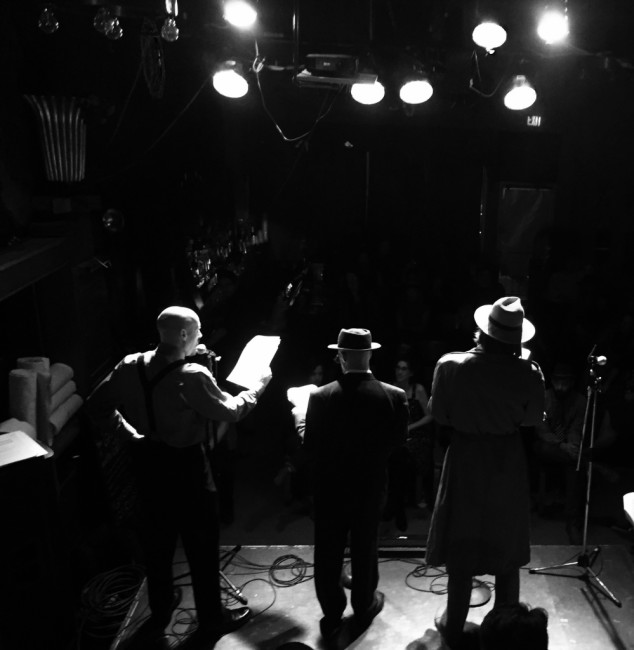
So for one audience member, my brilliant piece of work might be received as “That’s two hours I’ll never get back.” And they’re not wrong. For another audience member it might be, “Well that was slightly better than Netflix and at least I could get drunk.” And they’re not wrong. Or it might be, “You taught me something. You gave me a reaction that was significant, you gave me insight, etc., etc., you for me have created art.” The audience may say you are an artist because for them in that moment you have created art. The artist cannot say that. They cannot call themselves an artist. For the artist to call himself an artist is to imply that his little Fandango on stage is going to rise to the level of art for every single person that sees it. And that is the height of Hubris!
If you’re so against calling yourself an artist—
Craig: I don’t call myself an artist.
Okay, you don’t call yourself an artist. Why run a theatre company and produce art?
Craig: We don’t. I run a company that was started on a dare. We produce pranks.
I’m sorry, you produce what?
Craig: Pranks. I’ve said this forever. Think about it. If an artist in the moment of creating— whether that time is the amount of time it takes to say one line in a show or the three months it takes to paint a portrait or the ten years it takes to write a novel— if in the moment of creation the artist, let’s say the creator, if he or she is not focusing on the response he or she is striving for? But is instead focused on creating art? He’s a douchebag. He’s stealing the audience’s job and he’s diverting his audience from “I want to provoke a reaction” to “I want to be admired for provoking a reaction.” And the only people who appreciate that art are people who are being douchebags in encountering it.
As I’ve said for years, we don’t make art at The Yellow Sign Theatre. We play pranks. Because the purest way to focus on getting a reaction and not falling for that trap of “making art” is to say “this is a prank. We’re trying to get a rise.” For some people our pranks rise to the level of art. We did a show that was a tribute to Ruritanian Romances. It was set in that little European village that’s 100 years behind everyone else, on the night when the circus came to town. We put on a full spectacle show where the trapeze artist who was supposed to go had been murdered and we then revealed to the audience that they were playing the villagers of that little European Village where we’d set our story.
It was an interactive mystery and they didn’t know that when they came. They had to question the actors in character. We turned half of Club Charles into The Yellow Sign Tavern, the village tavern, and the theatre was the town square. Hell, at Scott Burke’s insistence we had three different endings written and we were performing for four nights so we were just going to repeat an ending, Scotty made us change an ending ten minutes before we went on because he came up with a really good idea.
That show had one driving theme beyond all of that— and we had a lot of themes going on there: reviving Ruritanian Romance, astonishing the audience with our circus work, amusing them with the carnie tricks— but do you know what the driving force of writing that show was when Benji Loveless and I were scripting it? Let’s try to trick Hipsters into LARPing. It was a prank.
You operate purely based on the principle that you intend to trick people into—
Craig: Not trick people. Prank them. Get a rise out of them. We simply want to get a reaction. If that reaction for an individual person and what they bring with them rises to the level of art, then they get to say we made art.
Do you think your company is serving a need in the grander scheme of the Baltimore area theatre scene?
Craig: Well it’s serving a personal need. The kind of self-conscious arty bullshit that we see all too often is what drove me out of the goddamned theatre for 20 years. I didn’t want to be associated with that shit. If we serve any need whatsoever it is to say “Maybe things are more than five years old actually are cool. Or things that aren’t on the approved ‘cool’ list might actually be cool.” Maybe sincerity is more important than arty-ness in getting something across. And the other purpose I think we serve is in making us all realize that if I am an artist I am no more special than a plumber.
How so?
Craig: The myth of the artist has created the notion that to be an artist is to be touched by fire, to be special, to be outside the norm, etc. etc. Fuck that. We serve a need. Human beings have a need to encounter some sort of symbolic universe that’s larger than themselves. Human beings also have a need not to get cholera. If you don’t want to get cholera or dysentery in your house? You hire a plumber. If you want to have a potentially larger-symbolic-universe experience? You hire an artist. The hiring process is different. But ultimately when it comes down to it we’re working stiffs and we should never think of ourselves as anything other than working stiffs.
You’re going to talk about all of this—
Craig: In 20 minutes.
Bullshit. But I’ll give you a few more questions, even though you’re 38 minutes into tape now. What is it that you hope to gain by participating? Drawing awareness to Yellow Sign? Drawing awareness to the principles under which YST operates?
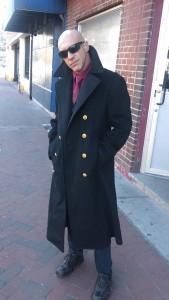
Craig: I think it’s nice to draw awareness to Yellow Sign, that’s a great thing. I think it’s great to remind people that they should and can broaden their awareness of what’s out there. Looking backwards is better because it reminds us that nothing is new. But the biggest impact that I would like to have is for both audiences and artists to get the fuck over the notion of being an artist.
And you really think you can communicate that in 20 minutes or less?
Craig: Yes. Is it going to be totally effective? No. It’s going to be provocative. I always make ridiculously provocative statements and then I explain why I feel as strongly as I do about them. And generally people realize there is a point in there. Maybe they don’t feel as strongly about it, but they see the point. I met someone tonight who is going to throw a 1920’s/1930’s themed supper-club fundraising event and she wanted Lucas (YST’s magician in residence The Most Marvelous Gerace) as a magician, and we were talking about music and I said “you have to have some Django Rhinehart.” I’m sure she’s heard his music but just doesn’t know that she has.
I think you have to remember that your specific exposure to the past is far more knowledgeable and vast than most.
Craig: Right. But that shouldn’t be. And that is my point. It ain’t that hard to get exposed.
This is true, it is not. However, a lot of things that get lumped into that blanket-category of “the past” don’t necessarily have the broad-spectrum appeal to the masses.
Craig: If you see something that you don’t understand in a piece of work that you like and you don’t follow it up to see where it came from? You are lazy and disrespectful. I don’t care about the masses. I’ve said many, many times I don’t care if only two people come to a Yellow Sign show as long as they’re the right two people. Case in point Rocky Horror, do you know how many people do not know who Steve Reeves is? Or do not know that there are 11 classic science fiction films mentioned in the theme song? Much less have seen all of them? And that’s the inspiration for Richard O’Brien making the damn movie!
Sure, but how many people know that outside of you?
Craig: I didn’t know that until I said “wait— I recognize Flash Gordon and I’ve heard of a thing called Day of the Triffids, maybe these are all old movies.” And I chased them down. Because that’s what you do when you like something. You chase them down. And I did. Now I can name them all— let’s see— The Day the Earth Stood Still, Flash Gordon, The Invisible Man, King Kong, It Came From Outer Space, Doctor X, Forbidden Planet, Tarantula, Day of the Triffids, Night of the Demon, and When Worlds Collide.
So you chased it down and learned everything you could about it. Why?
Craig: Because it gives you the ability to appreciate what you’ve seen!
Why is appreciating what you’ve seen so important?
Craig: Because if you’re getting something out of the experience, don’t you want to get the most you can? Take Rocky Horror, Richard O’Brien was writing about feeling like a freak. All he could do was sit and watch old science fiction films on TV and feel more comfortable in those worlds than in the real one. If you watch those movies you understand why they appeal to him, and particularly to someone who felt isolated and different from everyone else, and odd and not in the right world. If you don’t see those movies it doesn’t mean you won’t enjoy it as much but I do think there is a greater enjoyment to be had in being able to appreciate what you’re seeing.
Anything else you’d like to say about encouraging people to come see your talk?
Craig: It’s only 20 minutes it won’t kill you.
It might kill you trying to get it all to fit into 20 minutes. Anything else?
Craig: The hotel is lovely. Absolutely lovely. Come see the hotel.
Art Doesn’t Have to be Arty, in Fact, it Shouldn’t Be occurs on Wednesday December 9, 2015 at Hotel RL Baltimore— 207 E. Redwood Street in Baltimore, MD— at 8:00pm. The event is a free event.
For more information on what Craig Coletta gets up to with his company, visit the Yellow Sign Theatre Facebook page.
Yellow Sign Theatre’s Magician in Residence L. G. Gerace, Most Marvelous will be delivering his own Hotel RL The Living Stage presentation on Friday December 12, 2015 at 8:00pm.
To read about L.G. Gerace, Most Marvelous’ weekly Wednesday show Smirk & Mirrors, click here.

